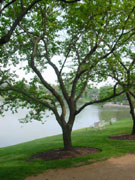


Home
Flowers &
Indoor Plants
Fruits & Nuts
Ornamentals
Vegetables
Special Topics
Resources
Glossary

|
Apricot Prunus armeniaca (Proo-nus ar-meen-ee-ah-cah) 



Click on thumbnails for larger image. |
 |
What about it? The apricot is a 2-3 inch long peach-like fruit. It is native to China and Siberia and records suggest it was introduced to the Mediterranean about 100 BC. It reached England before AD 1500, where it was called 'Abricock' and cultivated against south-facing walls or in glasshouses. There is only one commonly cultivated species. Favorite New York varieties include 'Goldcot' and 'Alfred: What is it used for?Apricots are usually enjoyed fresh, canned or used for jams or flavoring. Apricots can also be dried and eaten as a snack. The high price demanded for quality apricots is often incentive for apricot-lovers to try growing them at home. Some people grow the attractive small to medium sized tree for its ornamental qualities as well. Where does it grow? How do we grow it? Apricots are very demanding; if they had a choice, they would probably choose to live in a Mediterranean climate. They prefer deep soil; heavy wet areas should be avoided. Apricots do best in dry areas, especially with low rainfall at blossom and at maturity. They must have full sun. Apricots should be spaced at about 15 feet between plants. What are its primary problems? The skin of apricots is easily damaged by pests and diseases. Freckling or spotting on the surface of the fruit can seriously reduce the economic value of the crop. This may be caused by early attacks of blast, European red mite, and bacterial leaf spot. Bacterial canker and crown gall can also cause problems. Brown rot at harvest causes fruit loss. How do we harvest and store it? Apricots are individually hand picked. Fruit will last 1-2 weeks if picked when green has faded to pale straw color. The most wonderful flavor is achieved when picked fully ripe from the tree.
© Copyright, Department of Horticulture, Cornell University. |